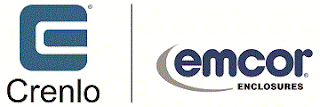– Steven Leidig, manager of enclosure engineering at Crenlo (www.crenlo.com/enclosures), says:
In Part 1 and Part 2 of this post, I discussed the importance of having an established design in place prior to procuring racks or enclosures for the data center. All too often, a procurement agent will provide too little information to the enclosure manufacturer, which can lead to project delays and increased long-term cost of operation due to inefficient design. Thus, I suggest that procurement not take place until seven key questions can be answered by the purchasing agent. This post will outline numbers 4 through 7.
4. What size of enclosure will be a sufficient long-term solution?
Size often seems a relatively easy decision to make based on the number of rack units needed to house all the equipment and accessories, but there are a couple of factors that buyers often fail to consider, the most common of which is the possibility of future growth. Purchasing without regard for future growth could mean significant modifications or horizontal expansion of the data center footprint, which takes up valuable space.
As an example, I’ve seen a community college that had a small server room with racks packed to capacity.
When the time came to expand, they had to expand into another space, ultimately eliminating a classroom. The ceiling in the server room was such that it would have accommodated much taller racks, so if they had purchased racks with extra rack units to begin with, they probably could have avoided expanding into another room.
The other factor buyers often fail to consider is the size constraints of building elements, such as service elevators and doorways through which the enclosure will have to pass in order to be installed. If this information is provided, enclosure manufacturers can easily build modular products to fit through tight spaces.
As an example, we’ve actually had to develop enclosures that required a unique modular configuration that allowed for final assembly after passing through the small hatch of a submarine. The same concept can be applied to normal data center installations; however, it’s quite common for us to hear from customers who don’t think of size constraints until they realize the enclosure doesn’t fit in the elevator. At that point, they either have to make time-consuming modifications, or ship it back to us and start from square one.
5. What is the footprint of the space in which the enclosure will be installed?
Any information on the installation room layout can help the manufacturer determine proper enclosure configuration, avoiding costly and time-consuming in-house modifications. If a buyer can provide information on the predetermined locations of the A/C supply and cabling in the server room, that will allow us to put the intake locations in the most efficient places, but it’s still very common for us to have to give them advice on how to modify the enclosure to accommodate those types of things during or after installation.
6. What type of equipment is being installed, and what is the ambient temperature of the operating environment?
These are the two most important questions to help enclosure manufacturers determine airflow design and the selection of all the enclosure components that affect airflow. By knowing the type of servers, we can use the wattage and the fan locations to determine waste heat generation and airflow paths in order to recommend the proper location and type of A/C unit, heat exchanger or blowers, as well as the right type of enclosure panels and doors — whether they’re solid, louvered or perforated. It’s no secret that airflow efficiency is one of the most important factors in reducing power costs and keeping electronics running smoothly, but this type of information is still not often provided upon initial customer request. See Figure 3.
7. How will the equipment be serviced, and which areas need to be regularly accessed?
The amount of time a data center manager spends servicing equipment can be drastically decreased if the enclosure is designed in such a way that accessibility to key components is easy and efficient. If a technician expects to need access to a particular component pretty regularly, it makes sense to include an access panel on the side or back, so that the door doesn’t have to be removed each time. As far as cabling goes, having a patch panel can free up space, making service easier.
Another important factor in serviceability is the location of the wire pass-through grommets. Simply informing the manufacturer of the size and voltage of the PDU will help determine the proper location of wire pass-throughs. This information is rarely presented, but can drastically decrease the amount of time technicians spend rerouting cable.
As an example, I recently visited a news station that was converting to high definition. The technicians had to reroute about 6,000 cables, and because the holes in the enclosure were not efficiently located, the technician probably spent at least an extra minute on each cable. That doesn’t sound like much, but with 6,000 cables, that equates to an extra 100 hours of labor.
Bottom line
Whether due to procurement taking place too early in the design or a lack of communication between purchasing agent and designer, not providing adequate information to an enclosure manufacturer can lead to project delays and increased cost due to inefficient design. With today’s enclosure manufacturers increasingly taking a configure-to-order approach to sales, buying the most efficient enclosure solution is easier than ever — so long as the buyer can answer the seven preceding questions.


